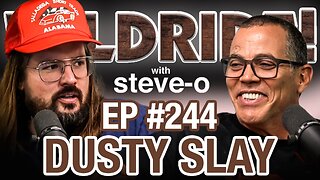Premium Only Content

The 1620 Project by Peter Wood, a response to the 1619 project. A Dalek (TM) Precis
NOVEMBER SIXTEEN TWENTY.
EDWARD DOTY signed it. So did Edward Leister.
That agreement came to be known as the Mayflower Compact, and it was signed aboard ship, November 11, sixteen twenty.
Their ship, the Mayflower, was supposed to have brought the would-be settlers to Virginia, where they would have been under English law and English protection, but was blown off-course to the shore of what is now Massachusetts.
By penning the Compact, however, they planted a seed. The document sketched, for the first time in European settlement of the New World, an ideal of self-government based on justice.
A “civil body politic” is simply a group of people who agree to govern themselves by common rules to be created through peaceful deliberation. That means it isn’t a tribe, a dictatorship, or an aristocracy. It offers an ordered public life under the rule of law.
The Mayflower Compact dealt not with membership in a church. Rather it announced the creation of a community that included all sorts, Separatists and Strangers alike.
The Compact was not the actual American founding, but a crucial pre-founding, informing the beginning of the American republic. It was a rough-and-tumble beginning, with death by starvation and disease awaiting many. But it has rightly been seen as the moment when an idea of true self-government began to take root.
AUGUST SIXTEEN NINETEEN.
EDWARD DOTY and Edward Leister were among several English servants who landed at Plymouth in November.
Fifteen months earlier, however, English pirates had landed some twenty to thirty African captives at Jamestown, Virginia.
So what happened to the “20 and odd Negroes” that Captain Jope brought to Jamestown? It is a matter of debate.
But unlike the slaves of later times, they had a genuine opportunity to work their way out of bondage, and they had basic rights under the law. A major scholarly examination of the African Americans at Jamestown, published in 2003, suggests that the best term for the condition of the involuntary immigrants of sixteen nineteen is “servitude,” and that the transition to slavery lay years into the future.
Not all historians agree.
Most notably, Alden T Vaughan, writing in the 1980s, concluded that all the Negroes who were brought to Virginia in this early period were considered slaves, not indentured servants.
The Times’ sixteen nineteen Project commences with a historical claim that doesn’t match the known facts.
The Times’ willingness to embrace fake-but-accurate history means they are all too likely to embrace history that is both fake and inaccurate – and not even realize how far they have strayed from the true record of the past.
Americans may have become familiar with the dangers of “fake news,” but fake history is more insidious. Fake news is typically met with rebuttals by many people who know the facts. Fake history, by contrast, often settles into the background as something “everybody knows.”
Ira Berlin recounts that “at least one man from every leading free black family – the Johnsons, Paynes, and Drigguses – married a white woman.” And “free black women joined together with white men. William Greensted, a white attorney who represented Elizabeth Key, a woman of color, in her successful suit for freedom, later married her.”
Indeed, nowhere on the planet in sixteen nineteen can one find an advanced society or civilization functioning without servitude and forms of prejudice and hierarchy.
The General Assembly appeared in no haste to distinguish these involuntary immigrants from other laborers, and so for several decades the colony accommodated itself to people pursuing their interests with little regard to racial distinction. This fluidity, of course, was not to last, but for a time, race in America harbored an alternative future.
AUGUST 2019.
THE SUBSTANCE OF the sixteen nineteen Project cannot be separated from its packaging. The project is above all a media campaign, which commenced with the publication of the special issue of The New York Times Magazine.
For an endeavor that presents itself as declaring a world-changing truth, the project is marred by an astonishing number of errors, misstatements, and omissions.
Hannah-Jones’s reputation pre– sixteen nineteen Project was based on her writings about school segregation. In 2017 the MacArthur Foundation, known for its extravagant financial support for progressive activists (as well as others in the sciences, humanities, and arts), awarded her one of its “genius” grants for “chronicling the persistence of racial segregation in American society, particularly in education, and reshaping national conversations around education reform.”
Of course, people from all fields may have important things to say about the sixteen nineteen Project. But in their public events, Hannah-Jones and the Times’ other prominent voices on sixteen nineteen have been focused so far on perfecting harmonious agreement with their original ideas.
Hannah-Jones has made many appearances, but at none of them has any form of intellectual challenge been welcomed. The word for this is not “dialogue.” It is propaganda.
After the riots that tore through American cities in the wake of the death of George Floyd in police custody, the Claremont Institute’s Charles Kesler, writing in the New York Post on June 19, drew a connection between Hannah-Jones’s myth-making and the rhetoric of those who had turned to arson and looting. Kesler said we could call these the “sixteen nineteen Riots,” and Hannah-Jones quickly responded by tweet, owning the phrase: “It would be an honor. Thank you.”
1776.
THE sixteen nineteen PROJECT has attracted critics the way a porchlight attracts moths – and with much the same effect.
In the early days of the promotional campaign for the project, Hannah-Jones made a point of emphasizing the extraordinarily high standards she set for herself and other contributors. She told one host of a panel discussion, “When you see the finished product you can’t really understand all the messiness and ugliness and despair that goes into making it. It was definitely the hardest thing both emotionally and just in terms of the pressure to get it right – not something that would further demean our ancestors; to tell the story the best way and also to understand every fact had to be right because I knew people were going to come for this reframing.”
The sixteen nineteen Project aims to unseat white supremacy by bringing forward a powerfully unified version of those insights that black Americans have had all along but have never before had the opportunity to express as a complete narrative. This is what Hannah-Jones means when she blogs that the project will not only reframe the history of America but also reframe “the unparalleled role black people have played in this democracy.”
The sixteen nineteen Project isn’t all bad. It is just wrong in crucial places.
The ideals that Jefferson gave voice to in the Declaration of Independence, however, reached far beyond the sometimes tawdry circumstances of his life.
In seventeen seventy six Jefferson busied himself in Philadelphia in composing a denunciation of Britain’s mistreatment of the American colonies. But, says Hannah-Jones, he left out the real reason the colonies are seeking independence: “Conveniently left out of our founding mythology is the fact that one of the primary reasons the colonists decided to declare their independence from Britain was because they wanted to protect the institution of slavery.”
In fact, one would be hard-pressed to find another historical subject that has produced a greater volume of scholarship over the last half century than slavery. American historians have rightly seen it as a crucial part of our past and a reality that continues to bear on the present.
No valid history can make the entire history of America, from the colonial era, to the republic, through the Civil War, to the present as only about slavery or slavery and racism together.
1775.
WHEN THE HISTORIAN Sean Wilentz pointed to the “cynicism” of the sixteen nineteen Project’s thesis, his criticism was impossible to ignore. Wilentz is a chaired professor of the American Revolutionary Era at Princeton University.
The linchpin of that cynicism is Nikole Hannah-Jones’s essay in which she asserts that “one of the primary reasons the colonists decided to declare independence from Britain was because they wanted to protect the institution of slavery.” Wilentz, having spent much of his career studying the actual reasons the colonists decided to declare independence, will have none of this. He goes after Hannah-Jones’s supposed evidence for her extraordinary claim.
His conclusion: “Revolutionary America, far from a proslavery bulwark against the supposedly enlightened British Empire, was a hotbed of antislavery politics, arguably the hottest and most successful of its kind in the Atlantic world prior to seventeen eighty three.”
Actual evidence, however, that the Somerset decision jolted the slaveholders into fearing an abolitionist Britain – let alone to the extent that it can be considered a leading impetus to declaring independence – is less than scant.
On the most generous interpretation, what the sixteen nineteen Project has done is pick sides in a scholarly dispute initially without citing sources and then consistently without acknowledging that the experts have sharply different views.
MARCH 20-20.
IN MID-MARCH 2020, as I worked on this book, I had a stack of 138 articles that had been published to that point either supporting or criticizing the sixteen nineteen Project.
The criticisms of the sixteen nineteen Project from the free-market-oriented segment of the political spectrum are wide-ranging but focus especially on the claims of the Times’ contributors who trace American capitalism and American prosperity to black slavery.
A sixteen nineteen derived demand for “antiracism” as a new way of life has emerged as a penitential cult – a religion of shame – embraced by hundreds of college presidents, corporate boards, and political leaders.
A substantial portion of that indoctrination is the effort to instill racial animosity and the conviction among African Americans that they are now and have always been the victims of systemic racial oppression.
This is the soil out of which the sixteen nineteen Project grew.
The National Education Association (NEA), the nation’s largest teachers’ union, with more than three million members in more than fourteen thousand communities, announced that it “recently worked with The New York Times to distribute copies of The sixteen nineteen Project to educators and activists around the country to help give us a deeper understanding of systemic racism and its impact.”
In January 20-20, a Milwaukee teachers’ union, MTEA, promoted Milwaukee Black Lives Matter at School National Action Week with a campaign that likewise touted the sixteen nineteen Project. So did the California Teachers Association, which provided the trifecta of Black Lives Matter at School, the Zinn Education Project, and the sixteen nineteen Project.
MARCH 1621.
WHAT SAVED THE PILGRIMS is well known yet still astonishing. One day – March 16, sixteen twenty one– a Wampanoag chief walked into their settlement and said in English, “Welcome! Welcome Englishmen!” Events unfolded rapidly in the Pilgrims’ favor in the weeks and months that followed.
The first contact with the Plymouth settlers went well.
The Pilgrims survived, just as the schoolbooks for generations have said, because the Indians taught them how to live in their new landscape, but also because the Pilgrims fell into a useful place in the complicated chessboard of alliances and hostilities among half a dozen Native American tribes. Mutually beneficial misunderstandings added to recognition of common interests. Neither side quite knew what the other wanted, but they contrived to get along, and the alliance lasted for twenty-five years.
APRIL 1861.
WHEN SOUTH CAROLINIANS fired the first shots of the Civil War, on April 12, 1861, at Fort Sumter in Charleston Bay, they imagined that the South held the upper hand in any ensuing conflict with the Northern states.
The South’s defeat in the Civil War put an end to the King Cotton conception of the American economy. Or so it seemed for about 150 years. But in the 20-10s, the idea was suddenly reborn among a handful of historians who are known for their contributions to what is called the “new history of capitalism,” sometimes referred to as NHC.
The essay by Matthew Desmond is titled “In Order to Understand the Brutality of American Capitalism, You Have to Start on the Plantation.”
As Desmond pieces things together, the United States embarked on this low road during the era of cotton plantations: “That culture would drive cotton production up to the Civil War, and it has been a defining characteristic of American capitalism ever since.” In this fashion, Desmond joins forces with Hannah-Jones to enunciate a new form of American exceptionalism in which the United States is uniquely awful
But comparisons to other countries vitiate both ideas. Cotton was successfully grown elsewhere in large quantities without slaves and without violence.
John Clegg, a fellow at the University of Chicago, and a contributor to the radical-left journal Jacobin, joins the debate at a different point. Clegg observes that cotton was a widely traded commodity and America’s principal export in the antebellum era, but he notes “that exports constituted a small share of American GDP (typically less than 10 percent) and that the total value of cotton was therefore small by comparison with the overall American economy (less than 5 percent, lower than the value of corn).”
Phelan goes on to link Desmond’s fantastical estimates of the South’s cotton wealth to the wild claims of Ta-Nehisi Coates, who testified to Congress that, “by 1836 more than$600 million, almost half of the economic activity in the United States, derived directly or indirectly from the cotton produced by the million-odd slaves.” Horrifying if true, but in fact “the number is completely bogus.”
JANUARY 1863.
IN HER LEAD ESSAY for the sixteen nineteen Project, Nikole Hannah-Jones calls out Abraham Lincoln as a racist. Her evidence for this charge is an August 14, 1862, White House meeting between Lincoln and five black leaders in which Lincoln “informed his guests that he had gotten Congress to appropriate funds to ship black people, once freed, to another country.”
Lincoln said, as Hannah-Jones quotes him: “Why should they leave this country? This is, perhaps, the first question for proper consideration. You and we are different races. … Your race suffer very greatly, many of them, by living among us, while ours suffer from your presence. In a word, we suffer on each side.”
But there is more to the story.
On January 1, 1863, President Lincoln issued the Emancipation Proclamation. It announced that the slaves in the states held by the Confederacy “shall be then, thenceforth, and forever free.”
In October 1854 he gave two major speeches, in Springfield and Peoria, that left no doubt about his profound antipathy to slavery. His three-hour Peoria speech on October 16 is generally understood as the foundation of his subsequent public career.
Yes, Lincoln had long been an advocate of black colonization schemes, as had been many others, white and black, since the founding in 1816 of the American Colonization Society by Robert Finley.
Defenders of Lincoln against Hannah-Jones’s scurrilous attacks are not in short supply.
To state flatly, as Hannah-Jones’s essay does, that Lincoln “opposed black equality” is to deny the very basis of his opposition to slavery.
Michael Vorenberg is a professor of history at Brown University who, in his essay “Abraham Lincoln and the Politics of Black Colonization,” argues that Lincoln used “the prospect of black colonization to make emancipation more acceptable to conservatives and then abandoned all efforts at colonization once he made the determined step toward emancipation in the Final Emancipation Proclamation
Lincoln had taken the unusual step of inviting a newspaper reporter, who created a verbatim account of the meeting. Knowing that Lincoln had invited this reporter changes altogether the meaning of what Lincoln said.
OCTOBER 1621.
ON OCTOBER 3, 1863, three months after the Union victory at Gettysburg, Lincoln declared that the United States would celebrate an official Thanksgiving on November 26. Federal Thanksgiving celebrations were not a regular custom at the time.
The Pilgrims at Plymouth were known to have celebrated a three-day thanksgiving feast with the Wampanoag Indians sometime in the fall of 1620, between late September and early November.
Ample evidence attests to Plymouth’s falling short of any utopian ideal. Like any human community, it had fractures, lawbreakers, and abundant challenges.
A key ingredient in this emerging identity was the colony’s gratitude. The relative material abundance it had gathered by October 1621 was not something it took for granted.
But mostly, they thanked God for his providence, and they did indeed hold a Thanksgiving celebration.
In her original sixteen nineteen essay, Hannah-Jones doesn’t mention reparations for slavery, but soon after, she avowed that seeking reparations was her true purpose.
Such reparations, she says, are not just for slavery but for the one hundred years after slavery, and they will have to consist of cash payments to every black American who has a slave ancestor. Their purpose will not be to erase racism, bring about racial harmony, or fully pay what whites owe blacks; they will simply be a form of “restitution” for what has been wrongfully taken away from blacks.
She freely admits that such payments will do nothing to improve race relations and won’t expunge any moral debt. They are simply “what is owed.”
There is no gratitude to be found in the sixteen nineteen Project, only bitterness and anger. It is a bucket lowered into the poisoned well of identity politics.
JANUARY 2020.
THOUGH I HAVE TRACKED some of the criticisms by professional historians of the sixteen nineteen Project, I have left unnoted a great many contributions by historians to the criticism and to the defense of the project.
“sixteen nineteen and All That” is a comprehensive dismissal of the criticisms by all the historians who had written to the Times, and who had done interviews with the World Socialist Web Site.
He is surely right that “many historians” do accept the sixteen nineteen Project’s anti-American thesis. Anyone paying attention to the history profession knows that.
Two responses to this deserve note. First, the historian Victoria Bynum strongly objected to Lichtenstein’s characterization of the critics that “all these historians are white.” She observed that racial “essentialism” underlies the sixteen nineteen Project itself, as well as “much of the public reaction against historians critical of sixteen nineteen.”
The second response is from David North and Tom Mackaman, two of the Marxists who write for the World Socialist Web Site. In their reply, they observe that Lichtenstein’s essay “reveals the extent to which racialist mythology, which has provided the ‘theoretical’ foundation of middle-class identity politics, has been accepted, and even embraced, by a substantial section of the academic community as a legitimate basis for the teaching of American history.”
I would leave Lincoln with the last word, but it seems important to add that we are left with a duo of hard-core Marxists to defend the integrity of American history from blasé historians, who think it no great matter that our history is being disassembled, falsified, and woven into a new fabric in the name of some sort of compensatory justice.
SEPTEMBER 2020.
THE PULITZER CENTER announced its partnership with the New York Times in an advertisement on the inside back cover of the August 18, 2019, issue of the Sunday magazine in which the sixteen nineteen Project was launched.
A newspaper that styles this project as something above and beyond factual reporting is, unsurprisingly, not willing to hold its assertions to basic journalistic standards.
Teachers, of course, have considerable flexibility in setting lesson plans and organizing their classes. But a project that aims at nothing less than “to challenge historical narratives, redefine national memory and build a better world” sounds like it rises to the level where responsible bodies above the level of classroom teachers should be actively consulted. In fact, the sixteen nineteen Project calls for a “reframing” of all American history, which should be a matter of grave concer for state boards of education, governors, and legislatures.
The Times considers the sixteen nineteen Project to be, above all, an educational endeavor. It aims to teach America truths about the past that have been suppressed or that have, until now, never been told properly. The Pulitzer Center aims to implement that vision by convincing teachers and school districts to adopt sixteen nineteen curricula drawn from or based on the sixteen nineteen Project.
In ordinary news reporting, the identities of sources are a crucial element, and in writing history, historians are duty-bound to identify the documents they examined and the experts they relied on. The Times dispensed with these procedures in the sixteen nineteen Project, which only here and there names a source or explains the basis of an assertion. The sixteen nineteen Project is thus not legitimate journalism, and it isn’t legitimate history either.
A good way to evaluate the Times’ claims about how American history has been taught over the generations is to consider the textbooks that have been used.
The sixteen nineteen Project carries the reaction into the realm of radical overreaction. It tells us, in effect, that we live in the land of the unfree, and it replaces the effort to tell a truthful history of America, with its failures as well as its achievements, with a story of nothing but failure.
There is no substitute for going to the Pulitzer Center’s website and reading through the material that is provided for classroom instruction, and in any case the effort to summarize it would capsize this book.
THE FUTURE.
IF THE SIXTEEN NINETEEN PROJECT were a term paper, any knowledgeable, fair-minded teacher would give it an F and be done with it. It demonstrates not only incompetence in handling basic facts, but also a total disregard for the importance of using reliable sources.
But the sixteen nineteen Project isn’t an incompetent term paper. It is a major declaration by the nation’s “newspaper of record,” with a plan to make its claims the basis for the teaching of US history in our schools.
A pirate ship really did bring slaves to Virginia in August sixteen nineteen. Slavery really did become an entrenched American institution in some colonies that became states during the eighteenth century. Cotton plantations in the American South really were in many cases hugely profitable, and cotton really did become a major American export.
There is an answer to the question, “Was America founded as a slavocracy?” – an answer in actual, documented history that does not depend on surmises or interpretative leaps. And the answer is, No, it was not founded as a slavocracy. It wasn’t founded as a slavocracy in Virginia in sixteen nineteen, or at Plymouth in sixteen twenty, or in Philadelphia in seventeen seventy six.
The sixteen nineteen Project is, arguably, part of a larger effort to destroy America by people who find our nation unbearably bad.
The sixteen nineteen Project thus consists of an effort to destroy America by teaching children that America never really existed, except as a lie told by white people in an effort to control black people. It eradicates American history and American values in one sweep.
The New York Times’ decision to launch this project in 2019 and to continue it indefinitely probably reflects the confluence of several motives.
Americans should know their history. That’s our best defense against malicious myth-making. Reading history books is not to everyone’s taste, which is a good reason why children should be taught history – so that they know some of it even if they don’t pursue it as adults. A citizen should grow up knowing we are a free people under the rule of law. A citizen should know that it is not some happy accident but the result of an immense effort over many generations.
And Americans should certainly learn about slavery. All Americans should learn that the struggle to end slavery across the globe started in Western culture and was advanced by the United States.
-
 1:02:59
1:02:59
PukeOnABook
27 days agoThe ten Nearest G Stars. A Puke(TM) Audiobook
983 -
 LIVE
LIVE
Fresh and Fit
6 hours agoIsrael-Hezbollah Ceasefire & Reacting To Death Threats On X
6,127 watching -
 1:11:10
1:11:10
Steve-O's Wild Ride! Podcast
5 days ago $7.11 earnedDusty Slay Went From Selling Pesticides To Having A Netflix Special - Wild Ride #244
21.1K3 -
 1:16:02
1:16:02
CocktailsConsoles
4 hours agoBE PART OF THE GAME!!| Death Road to Canada | Cocktails & Consoles Livestream
13.9K1 -
 LIVE
LIVE
Phyxicx
6 hours agoWe're streaming again! - 11/26/2024
201 watching -
 LIVE
LIVE
GamingWithHemp
6 hours agoHanging with Hemp #103
1,248 watching -
 21:24
21:24
DeVory Darkins
1 day ago $9.32 earnedElon Musk and Tucker Carlson SHATTER Left Wing Media
29.6K31 -
 15:13
15:13
Stephen Gardner
3 hours ago🔥Breaking: Trump JUST DID the UNEXPECTED | Tucker Carlson WARNS America!
25.5K59 -
 1:18:01
1:18:01
Glenn Greenwald
8 hours agoWill Trump's Second Term Promote Economic Populism? Matt Stoller On Cabinet Picks To Fight Corporate Power; Should Liberals Cut Off Pro-Trump Friends & Family? | SYSTEM UPDATE #372
166K144 -
 2:26:30
2:26:30
WeAreChange
8 hours agoTrump To Subdue Deranged Opposition! ARRESTS Planned
131K52